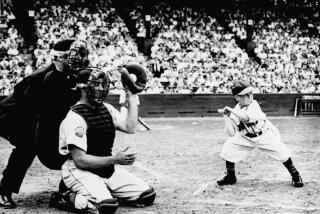Grange’s Performance Christens Illinois Stadium
- Share via
More than any other player, Harold “Red” Grange was responsible for taking pro football off high school fields and putting it in major stadiums.
But on this date 75 years ago, Grange christened 60,000-seat University of Illinois Memorial Stadium with a memorable college football performance.
The first four times he handled the ball that day against heavily favored Michigan, Grange scored on runs of 95 (the opening kickoff), 67, 56 and 44 yards.
He was removed from the game after 12 minutes.
In the third quarter, the 5-foot-11, 175-pound Grange returned and scored on a 13-yard run. In the fourth quarter, he passed for a sixth touchdown. His total yardage, including kick returns: 402.
Illinois won, 39-14. It’s still considered Illinois’ greatest football victory.
And Grange is still considered the man who made pro football a major sport. Before him, NFL teams played in Pottstown, Pa., Benoit, Wis., Canton, Ohio, Racine, Wis., Rock Island, Ill., and Decatur, Ill. The best players made $250 a game. They laundered their own uniforms and often slept in their cars.
The Chicago Bears signed Grange in 1925. After the season, the Bears took Grange to New York’s Polo Grounds, where 65,000 showed up for an exhibition game. Later, at the Los Angeles Memorial Coliseum, Grange drew a capacity 65,270--at the time the biggest crowd to see a pro game.
Also on this date: In 1977, the New York Yankees’ Reggie Jackson electrified baseball followers with three home runs in Game 6 of the World Series. . . . In 1996, the ill-fated American Basketball League became the first women’s pro basketball league in over a decade with its first night of games. The ABL lasted 2 1/2 half seasons before folding. . . . In 1968, in Mexico City, Bob Beamon shattered Ralph Boston’s world record for the long jump by almost two feet with a 29-2 1/2 leap at the Olympic Games. On the same afternoon, American Lee Evans ran a world record 43.8 to win the gold medal in the 400 meters. . . . In 1960, Casey Stengel, who in 12 seasons as manager of the Yankees led the team to 10 pennants and seven World Series triumphs, was fired by the club. Said Stengel: “I’ll never make the mistake of being 70 again.” . . . In 1924, sportswriter Grantland Rice penned his famous lead after covering the Army-Notre Dame game: “Outlined against a blue-gray October sky, the Four Horsemen rode again. In dramatic lore they are known as Famine, Pestilence, Destruction and Death . . . their real names are Stuhldreher, Miller, Crowley and Layden . . .”
More to Read
Go beyond the scoreboard
Get the latest on L.A.'s teams in the daily Sports Report newsletter.
You may occasionally receive promotional content from the Los Angeles Times.










